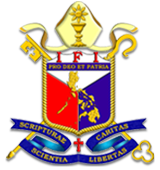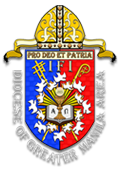UNDERSTANDING THE HOLY TRINITY
Reflection for the Trinity Sunday, May 30, 2021
Isaiah 6:1-8, John 3:1-17

By: The Rev. Vicky Esguerra
BACKGROUND
If there is anything inexplicable and incomprehensible to Christians, and non-Christians alike, the ideas of the Resurrection event and the mystery of the Holy Trinity seem like logical inconsistencies and great mysteries. But through these two enigmas the true faithful can discern and accept the heart and mind of God, defying the odds of world realities proving otherwise due to humanity’s naivete. The will of the Almighty God was (and still is) manifested in His commissioning and anointing of prophets, priests, and kings in the Old Testament, and still up to the present time in its own context.
In God’s love for the Nation Israel, He called Moses to lead the Israelites out of Egypt enroute to the promised land and to give order to their life through the Ten Commandments; and His sending of Isaiah to prophecy to reform Judah -- were only two examples of His care and concern for His beloved chosen people. The people He called to do their missions were not exemplary nor spotless in character; but through the sending of His only Begotten Son, Jesus Christ, climaxed by His passion, crucifixion, and Resurrection, the Almighty God showed that His unbounded love to humanity extended salvation to the Gentiles as well.
God did not only reveal His might and grandeur in the natural beauty of creation and miraculous acts to save His people (e.g., parting of the Red Sea); most importantly He built His people’s faith and trust in Him by unmasking His true identity in order to establish a really valid relationship with His own people. God showed the true essence and substance of the Holy Trinity in the Three Persons, God the Father, God the Son, and God the Holy Spirit: One True God co-existing in the Beginning, the Present, and the End. Though the idea of a One God in Three Persons is difficult to comprehend, the faithful Christians are given the proofs of the Holy Trinity through the events recorded in the Scriptures and, importantly, as well, from the Words of God spoken through the prophets, priests, and kings; whose ministries are now delegated to the role of the clergy (bishops, priests, pastors, etc.).
GOD THE FATHER
No one has (had) ever physically seen God the Father, although Jesus told His disciples that “If you have seen Me, you have already seen the Father.” In the Old Testament, God manifested His presence to His chosen people in many ways, including spectacularly through the provision of their needs in their Exodus journey through the wilderness (manna and springs of water) and guiding their way (cloud by day and pillar of light by night). Over a period of many generations, He spoke through their leaders: Abraham, Moses, Joshua, Isaac, Jacob, etc.; through the prophets and priests: Elijah, Elisha, Samuel, etc.; through their anointed kings: Saul, David, Solomon, etc.
The visionary experience of Isaiah the Prophet (Hebrew name meaning “God is salvation”) in front of the throne of God attested to His divine existence. The pre-exilic prophet was humbled and reluctant to heed his calling because of his confessed “unclean lips,” but God remedied the situation by the angel’s cleansing of his lips. No one could disobey God when sent to warn the people of their religious and moral transgressions, and to convey the good news of God’s redeeming love. By commissioning people, God continues on His good work in all generations through His chosen emissaries, despite their weakness in character, by properly equipping them for the assigned tasks.
In grateful response, the Israelites called their God Yahweh in various reverential names such as: “I AM WHO I AM” (alpha and omega, first and last letters of the Greek alphabet); EL (God of Israel); EL SHADDAI (“God” to the priestly group); EL OLAM (Everlasting God); EL ELYON (God Most High); ELOHIM (God in the Old Testament). As a sign of appreciation and gratitude for God’s amazing graces – victories in battlefields (King David), economic prosperity (King Solomon), bountiful harvests and good family relations, protection from the ravages of natural calamities and enemy assaults, etc. – the Israelites built Temples of Worship for God (Solomon, Zerubbabel, Herod the Great). They believed that it was in the Temple where their God Yahweh resided.
Their relationship with God was enriched by reading and living out the teachings of the Torah (First Five Books believed to be authored by Moses); observing the Sabbath, Jewish feasts and holidays; and obeying the rules of life grounded in the Ten Commandments. The Jews religiously followed the strict ethical rules orally handed down to them by their forefathers and passed on through the institutions of the family and the Jewish religious traditions. But their faith was confined on their belief only in God Yahweh and are still waiting, up to now, to the coming of the Messiah or the Anointed Savior to redeem them.
GOD THE SON, JESUS CHRIST
Before the Heavenly Father sent His beloved Son, Jesus, to the world, He first prepared the way for Him by choosing the people to become His own (Abraham and his tribe, and later his own descendants to all nations of the earth). Great men were selected through leaders, prophets, and kings to remind them of the coming of their Savior. From this people through the lineage of David was Jesus born of a woman (Mary) through the grace of the Holy Spirit; hence His two natures: divine and human. The Christians were (are) taught that the Way to the Father was (is) through Jesus: the Way, the Truth, and the Life.
God the Father informally introduced His Son, Jesus, in a most humble venue at the Jordan River as witnessed by a small crowd and testified by John the Baptist, His cousin and forerunner, who performed the Baptism of Water on Jesus. Thirty years earlier, before that baptismal event, the cosmic sign (Star of Bethlehem) already revealed to the world the birth of a great King, coveted by King Herod the Great, yet Jesus’ official commissioning came the first time only when God’s Voice confirmed in His theophany (“theopania” Latin for manifestation of God) that Jesus was (is) “His beloved Son, with whom I am well pleased.” Simultaneously, God’s sending of the Dove of the Holy Spirit consolidated the presence of the three Persons in the Holy Trinity.
On this momentous occasion, Jesus’ ministry was launched as the “Good Doctor” to the small humble town of Galilee. Calling His followers to be relatives and friends from this area, Jesus started His ministry of preaching, healing, exorcism, and teaching against injustice and oppression; as well as teaching His disciples on the rudiments of ministry. Though His divine nature gave Him physical and spiritual prowess, however, the limits of His human nature were evident at times when he retreated to pray and commune with His Father to regain His strength after a hard day’s work. As recorded in the Bible, His disciples witnessed His human emotions at times, i.e., wept at the grave of Lazarus, furious during the cleansing of the Temple, annoyed at His disciples’ impertinence, irritated by the intimidations of the religious hierarchy, etc. Despite all these human frailties, Jesus’ mercy, kindness, tolerance, and compassion showed His infinite and unbounded love for His people.
For the second time, the Almighty God’s Voice was heard to re-affirm Jesus’ Sonship in the Transfiguration’s Baptism of Fire, this time directed to the three disciple witnesses, Peter, James and John: “This is My Son, My Chosen, listen to Him!” The core group of disciples were aware of Jesus’ Messianic role, yet were not cognizant of the depth of suffering and death that Jesus was about to endure. As special friends, they too were not conscious of the “same cup of sacrifice” that they had to drink. The strength of their faith was tested when only John the Beloved Disciple stood witness at the foot of the cross during Jesus’ most agonizing hours. The rest of His friends deserted or betrayed Him, and they were only reunited in faith and trust after the Resurrection when Jesus was raised bodily by the Father from His tomb.
Following the horrific scenes of the crucifixion, the even more controversial news of Jesus’ Resurrection brought shock waves across the Nation Israel and the surrounding countries. Various versions of the story were circulated to justify that the news was fraudulent. Even up to now, non-believers conjure stories of misinformation and ridicule of those faithful believers. Though at that time eye-witness accounts could not all be recorded, only the learned and literate had the proficiency to do so. But the Bible authenticates more than 11 incidents of Jesus’ appearance during the 40 days after His Resurrection: (1) to Mary Magdalene (Jn 20:16-17; (2) to other women (Mary of Cleopas, Mary the mother of James and John) (Mt 28:8-10); (3) to Peter alone (Lk 24:34); (4) to the two men on the road to Emmaus (Lk 24:13-43); (5) to the ten apostles in Jerusalem without Thomas (Lk 24:36); (6) to the eleven apostles with Thomas (Jn 20:26-29); (7) to the seven disciples at the Sea of Tiberias (Jn 21:1-2); (8) to the whole number of apostles on a mountain in Galilee (Mt 28-16); (9) to 500 brethren (1 Cor 15:6); (10) to James the apostle (1 Cor 15:7); (11) to the small group on the Mount of Olives before His Ascension (Lk 24:50-53). There were also several occasions when He ate with His disciples and He blessed them. [Source: Henrietta Mears, “What the Bible is All About,” Gospel Light Publications USA, 1953]
The Resurrection story proved that in God’s raising of Jesus He overcame the sting of mortal death and redeemed humanity of its sinfulness. The fact that He was “carried up” bodily in His Ascension revealed He was human. These scenes therefore attested to the divinity and humanity of Jesus; a fact difficult to accept but only through the gift of grace of the Holy Spirit. Jesus also, before His Ascension, revealed to His disciples that He would send the Holy Spirit the Advocate to help them in carrying out their difficult missions on earth.
GOD THE HOLY SPIRIT
If the Resurrection happening was difficult to grasp, so too was (is) the confusing role and existence of the Holy Spirit or the Third Person in the Holy Trinity. In the Old Testament the Spirit of God was visible in creation, nature, and anointing for particular occupations, such as: in the prophets for vision, priests for virtue, prince/king for victory, judges for wisdom, builders for skills, special talents like strength (Samson), etc. In the New Testament the Pentecost event was a testimony of the coming of the Holy Spirit visible as tongues of fire and indwelling on the apostles of Jesus. Suddenly they were given the ability to speak in foreign languages so they could make pronouncements on the truth of Jesus the Savior and Redeemer; likewise, the crowd was able to listen to their testimonies and subsequently got converted. According to Jesus, the Holy Spirit would continue the work which Jesus began with His apostles.
God the Father, through His Voice during the Jordan River baptism of Jesus, acknowledged the presence of the Holy Spirit descending in the form of a dove and alighting on the shoulder of Jesus. In God’s Will to perfect the human nature of our hearts, He sends the Holy Spirit to work in us through the Spirit of truth, faith, grace, holiness, wisdom, power, love, sound mind, life, and glory. In the Spirit of baptism, we are now one in Christ and member of the Body of Christ which is the Church. The Spirit of God is present in the grace of the sacraments which we receive in the Church. The Church as One Body bestows the spiritual gifts to its members as apostles, prophets, teachers, miracle workers, healers, speakers in tongues, interpreters of tongues (1 Cor 12:1-11). The Holy Spirit is represented both as a dove and fire, signifying the calmness or peace of the dove or the zeal of fire or courage of the Spirit of God.
RELATIONSHIP WITH THE HOLY TRINITY
The work of the Holy Trinity is discernible in the Bible passage John 3:16: “Gospel in miniature.” God the Father’s heart: He loved the world; God the Father’s mind: He sent His Son; God the Father’s will: He wanted everlasting life for humankind. Jesus’ heart: He loved and obeyed the Father; Jesus’ mind: His mercy, compassion, and redemption of humanity; Jesus’ will: abundant life for all. Holy Spirit’s heart: He loved and obeyed the will of the Father and the Son; Holy Spirit’s mind: He wants to magnify God the Father and the Son; Holy Spirit’s will: He wants to unify the Church for the good of the people and for the glory of God.
God the Father works in creation; God the Son Jesus in salvation; and the Holy Spirit in sanctification. How do we honor God’s creation by reducing the effects of climate change and the ravages of the natural disasters wrought by human greed and indifference? How do we show our love for Jesus’ sacrifices to redeem the world from sinfulness? How do we preserve the sanctity of the Body of Christ and work for the unification of the Church through one cup, one altar, and one baptism? How can we strengthen our faith in and glorify the Holy Trinity through our personal and collective prayers, living out our baptismal covenant, and loving our neighbors as ourselves through our thoughts, words, and deeds? Only through the grace of the Holy Trinity: Father, Son, and Holy Spirit. Amen.


